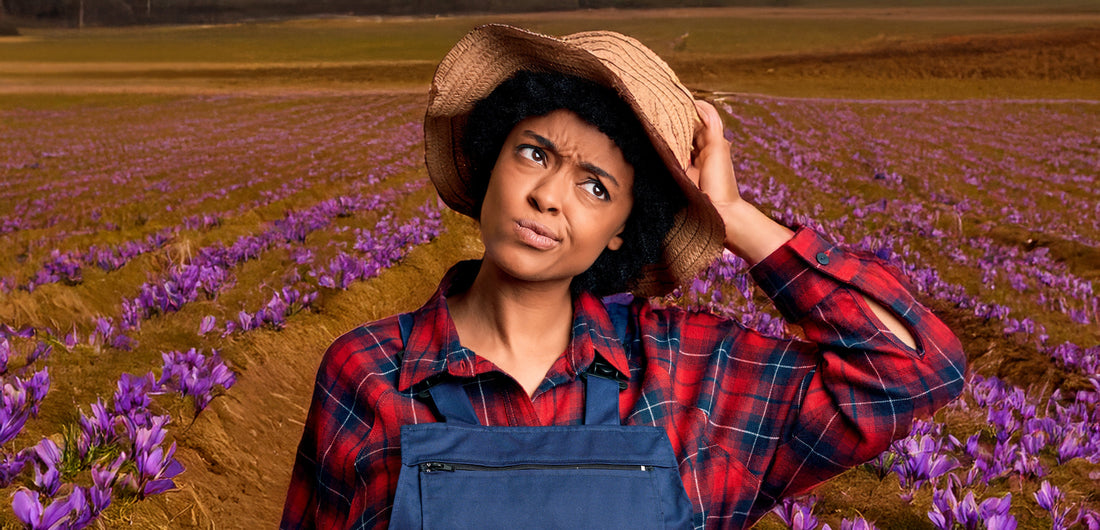
All saffron questions you were afraid to ask
Share
At Roco Saffron, we’ve heard it all. Whether you're planting your first 500 bulbs or managing a multi-acre field, you're bound to have questions. And sometimes, the most helpful ones are the ones no one wants to say out loud.
So, we’ve gathered 10 of the most quirky, surprising, and “is it just me?” questions we get about Crocus sativus bulbs—and we’re answering them here, farmer-style. No fluff. Just real answers from people who live and breathe saffron.
1. “Can I plant the bulbs upside down by accident?”
Yes… and unfortunately, it matters. The growing tip (pointy end) of the saffron bulb should face up. If it’s upside down, the sprout has to work harder to reach the surface, which weakens the plant and delays flowering.
✅ Don’t stress—if you’ve only planted a few that way, they’ll likely still emerge. But for large-scale planting, orientation counts!
2. “Do saffron bulbs like water… or hate it?”
Great question. The answer? Both.
- Saffron needs moisture during active growth (winter–spring), but
- Too much water = death by rot.
Always plant in well-drained soil. No exceptions. Raised beds, light soil, or adding sand can be game changers.
3. “Can I grow saffron in pots?”
You absolutely can—and it works surprisingly well on balconies, patios, or in greenhouses. Just make sure to use:
- A deep, well-drained container;
- Loose, sandy soil;
- At least 10–15 cm between bulbs;
- A dry rest period in summer.
It’s a great way to test saffron cultivation before scaling up.
4. “Do the bulbs multiply like garlic?”
Close! Saffron bulbs (technically corms) reproduce underground, forming daughter corms around the dying parent.
Each year, you’ll get 2–5 new bulbs per parent, depending on conditions. Over time, your planting expands naturally—but you’ll need to divide and replant every 4–5 years to avoid crowding.
5. “Can I eat the bulb like an onion?”
Please don’t. Saffron corms aren’t toxic, but they’re not tasty either—starchy, fibrous, and mostly grown for flower production, not food. Stick to using the stigmas in the kitchen!
6. “If one bulb rots, will it infect the others?”
Yes, it can. Fungal diseases like Fusarium or Penicillium spread through moisture and poor airflow. Always:
- Remove and discard any soft, smelly, or moldy bulbs
- Use clean tools and soil
- Rotate fields or refresh potting mix if you’ve had rot before
At Roco Saffron, we only ship firm, healthy, inspected corms to give you a disease-free start.
7. “Can I test bulb quality without planting?”
Totally. Here's what to check:
- Firmness: No soft spots or shriveling
- Size: Bigger = more likely to flower (we recommend 2.5 cm+ for flowering)
- Weight: Heavier bulbs have more energy reserves
- Smell: Should smell like clean soil, not mold
If you buy from Roco Saffron, every bulb is visually sorted and quality-checked by hand.
8. “Can I reuse soil from last year?”
Yes—but be cautious. Saffron soil should rest or rotate after several years. If you're growing in pots or the same bed annually:
- Refresh with clean compost or sterilized mix;
- Remove any old root fragments or debris;
- Test pH (saffron likes 6.0–8.0);
- Healthy soil = healthy bulbs.
9. “Can I grow saffron from seed instead of bulbs?”
Nope. Crocus sativus is a sterile triploid—meaning it doesn’t produce viable seeds. The only way to grow more saffron is by planting corms. That’s why sourcing strong, reproductive bulbs is essential.
10. “Do Roco Saffron bulbs really make a difference?”
We might be biased… but yes.
Our Crocus sativus bulbs are:
- Soil-free and disease-checked
- Carefully stored and temperature-managed
- Selected for strong reproduction and flowering
- Shipped with full documentation and guidance
We support you from first planting to first bloom—whether you're growing for passion, profit, or both. Got a question that didn’t make the list? Send it our way—we love hearing from growers at every level.
